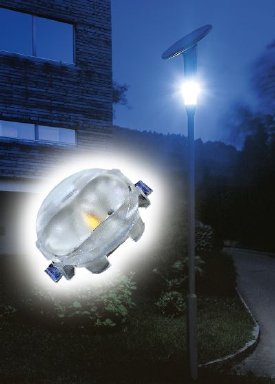Sep 2 2007
As communities with a commitment to environmental protection, Diex and Hörbranz (Austria) place great value on solar energy and low power consumption for their street lighting. This does not mean that brightness has to be compromised, however, as brilliant street lights equipped with Golden Dragon Oval LEDs amply demonstrate. OSRAM Opto Semiconductors has developed special oval lenses for this application that direct the light accurately onto the street.

Only twelve Golden Dragon Oval LEDs per street light are sufficient to illuminate cycle paths and footpaths from a height of 3.4 meters. They produce 60 lm each (at 350 mA) and are operated at 130 mA specifically for this application. The LED each consumes 0.35 W (1 W in standard applications). Their oval lens distributes the light down at an angle of 80° x 120°. This means that no light is lost sideways away from the path as is the case with the usual circular distribution of light from conventional street lights. Light is not spread in all directions, which cut down on light pollution.
The manufacturer EPS Soltec uses solar power to supply the lamps. Solar cells provide all the energy needed, and this energy is ideal for the light emitting diodes. The LEDs require a voltage of less than 10 V, do not need a 230 V ac power supply and therefore no inverters for converting the voltage.
What’s more, the LEDs do not require secondary optics and can be integrated in almost any luminaire design. The lighting can be adapted to ambient light conditions through dimming, and the color temperature can even be adapted by combining white and yellow LEDs. Their long and especially predictable life of around 50,000 hours reduces maintenance costs and therefore also operating costs. Because OSRAM LEDs comply with the RoHS directive and do not contain any lead or mercury there are no problems disposing of them at the end of their life.
LEDs are being used more and more in general lighting applications. In view of their excellent energy efficiency they will supplement and replace more and more traditional light sources over the coming years. In doing so, they will be making an active contribution to climate protection by reducing CO2 emissions.